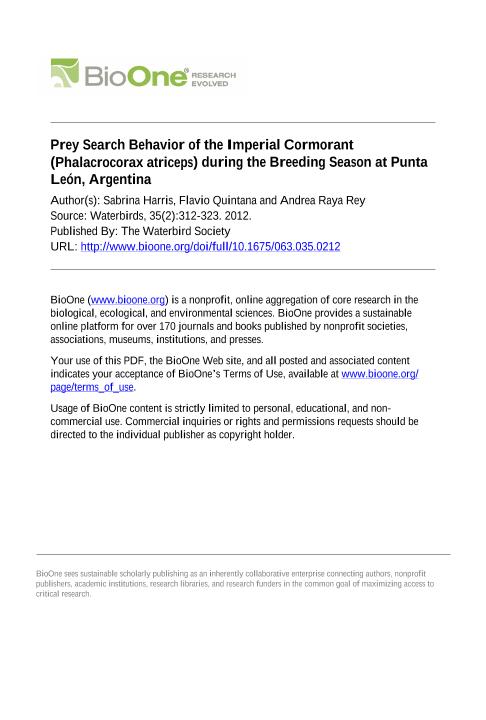Mostrar el registro sencillo del ítem
dc.contributor.author
Harris, Sabrina

dc.contributor.author
Quintana, Flavio Roberto

dc.contributor.author
Raya Rey, Andrea Nélida

dc.date.available
2018-12-07T19:51:03Z
dc.date.issued
2012-05
dc.identifier.citation
Harris, Sabrina; Quintana, Flavio Roberto; Raya Rey, Andrea Nélida; Prey Search Behavior of the Imperial Cormorant (Phalacrocorax atriceps) during the breeding season at Punta León, Argentina; Waterbird Society; Waterbirds; 35; 2; 5-2012; 312-323
dc.identifier.issn
1524-4695
dc.identifier.uri
http://hdl.handle.net/11336/66085
dc.description.abstract
Behavior by a foraging seabird during the breeding season can be examined by analyzing time invested throughout the foraging route to determine the presence of Area-Restricted Search (ARS) as well as other characteristics related to the shape of the foraging path and activity (flying, resting or diving). Forty-six Imperial Cormorants (Phalacrocorax atriceps), 18 males and 28 females breeding at Punta León, Argentina (43°04´S; 64°2´W), were fitted with GPS loggers recording one foraging trip (sampling interval: 1 second) in 2004, 2005, 2007 and 2008. Trip duration was longer, on average, for females (6.3 ± 1.9 h) than males (5.3 ± 1.6 h) (Mann-Whitney U test z 1,45 = 2.23, P = 0.026), but year had no significant effect on any of the path characteristics. ARS was detected in forty-three individuals, twenty-two of which made smaller scaled searches nested within larger ARS areas. Search scale was not correlated to maximum distance reached and did not differ between sexes nor years. Cluster analysis separated four types of behavior: short direct return trips (N = 7), long direct return trips (N = 31), random flight searches (N = 6) and loops (N = 2), with each behavioral type present in both sexes. Behavioral variability within a population may be due to differences in targeted prey type and spatio-temporal stability during the season, as well as to individual physiological constraints and life-history traits linked to how individuals search for food at sea.
dc.format
application/pdf
dc.language.iso
eng
dc.publisher
Waterbird Society

dc.rights
info:eu-repo/semantics/openAccess
dc.rights.uri
https://creativecommons.org/licenses/by-nc-sa/2.5/ar/
dc.subject
Area-Restricted Search
dc.subject
Imperial Cormorant
dc.subject
Phalacrocorax Atriceps
dc.subject
Search Behavior
dc.subject.classification
Otras Ciencias Biológicas

dc.subject.classification
Ciencias Biológicas

dc.subject.classification
CIENCIAS NATURALES Y EXACTAS

dc.title
Prey Search Behavior of the Imperial Cormorant (Phalacrocorax atriceps) during the breeding season at Punta León, Argentina
dc.type
info:eu-repo/semantics/article
dc.type
info:ar-repo/semantics/artículo
dc.type
info:eu-repo/semantics/publishedVersion
dc.date.updated
2018-12-05T14:35:19Z
dc.journal.volume
35
dc.journal.number
2
dc.journal.pagination
312-323
dc.journal.pais
Estados Unidos

dc.description.fil
Fil: Harris, Sabrina. Consejo Nacional de Investigaciones Científicas y Técnicas. Centro Científico Tecnológico Conicet - Centro Nacional Patagónico; Argentina
dc.description.fil
Fil: Quintana, Flavio Roberto. Consejo Nacional de Investigaciones Científicas y Técnicas. Centro Científico Tecnológico Conicet - Centro Nacional Patagónico; Argentina
dc.description.fil
Fil: Raya Rey, Andrea Nélida. Consejo Nacional de Investigaciones Científicas y Técnicas. Centro Austral de Investigaciones Científicas; Argentina
dc.journal.title
Waterbirds

dc.relation.alternativeid
info:eu-repo/semantics/altIdentifier/url/http://www.bioone.org/doi/abs/10.1675/063.035.0212
Archivos asociados
